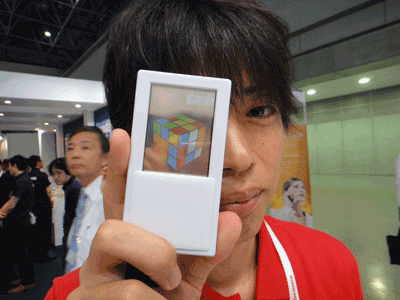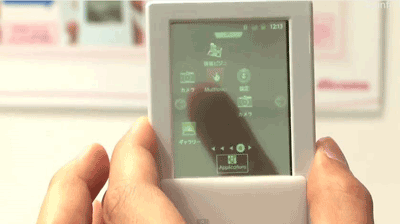Transparent double-sided smartphone demonstrated at 2012 Wireless Japan expo (video)
NTT DoCoMo and Fujitsu showcase exciting new device
Japanese wireless carrier NTT DoCoMo, along with global gadget manufacturer Fujitsu, recently demonstrated an exciting new prototype device at the 2012 Wireless Japan expo: a transparent, dual-sided smartphone.

NTT DoCoMo and Fujitsu have created the world’s first transparent smartphone.
The phone is the first of its kind and is generating some excitement because it presents several new possibilities for the smartphone market, where display designs have become increasingly ubiquitous and unoriginal.
About the phone
DoCoMo’s phone features a very small 2.4-inch display and a modest-at-best QVGA resolution (320 x 240 pixels). Touch sensors are available on both the front and flip sides of the screen, making the phone usable no matter how it’s held.
In terms of operating system, the device was shown running an older version of Android.
During the demonstration (video below), the user’s hand went behind the icons on the screen to use the touchscreen on the back, thus leaving the front display completely unobstructed. Depending on how the owner wishes to use the phone, he / she can control the device using touch sensory on the front, back, and sides, or otherwise touch both screens at once.

DoCoMo’s transparent phone offers unique double-sided control capabilities.
Another highlight shows the demonstrator working on a Rubik’s Cube. When he taps the front and back of the image, different results are produced; that is, the cube spins and moves its parts by way of the side-appropriate gestures. This is said to be the first time a phone has ever demonstrated a sort of “gripping” ability.
Video
In the video, the demonstrator holds the phone by its edges to show that both hands can interact with one of the two sides of the screen. He also shows how he can use the index finger of the hand holding the phone to display a dropdown menu on the back-facing touchscreen without obscuring the view of the front display at all.
It’s jaw-drop worthy, but it’s not ready yet
The phone still has some issues, the most obvious being its resolution and size:
• The phone has limited visibility in sunlight, making the transparent touchscreen all but useless outdoors.
• To put it lightly, a 2.4-inch OLED screen simply won’t cut it in today’s market. It needs to be bigger.
As you saw in the video, the folks at NTT DoCoMo recognize these issues and plan to address them should the phone head to market. The spokesperson acknowledged the phone’s size issue in particular, saying that the display is “quite small,” adding, “We think it needs to be bigger if we’re to market this kind of phone.”
The brightness problem might be the developer’s bigger headache, though. Any sort of transparent device pretty much equates to poor image quality under adverse lighting conditions. Users could place an object underneath the phone to gain some clarity, but that’s only a short-term solution, and one that’s far too much of an inconvenience to be an actual answer to the problem.
Outlook
Representatives from NTT DoCoMo foresee the phone being a big hit with the gaming community, especially those who would want to use its unique separate displays to participate in a two-player game.
Unfortunately, there’s no information pertaining to how the companies plan on commercializing the prototype, nor is there anything on price or release date. Regardless, the gadget community is all abuzz about the phone, and already talking about the many possibilities that it could one day offer.
Via: Diginfo.tv
Advertisement
Learn more about Electronic Products Magazine





